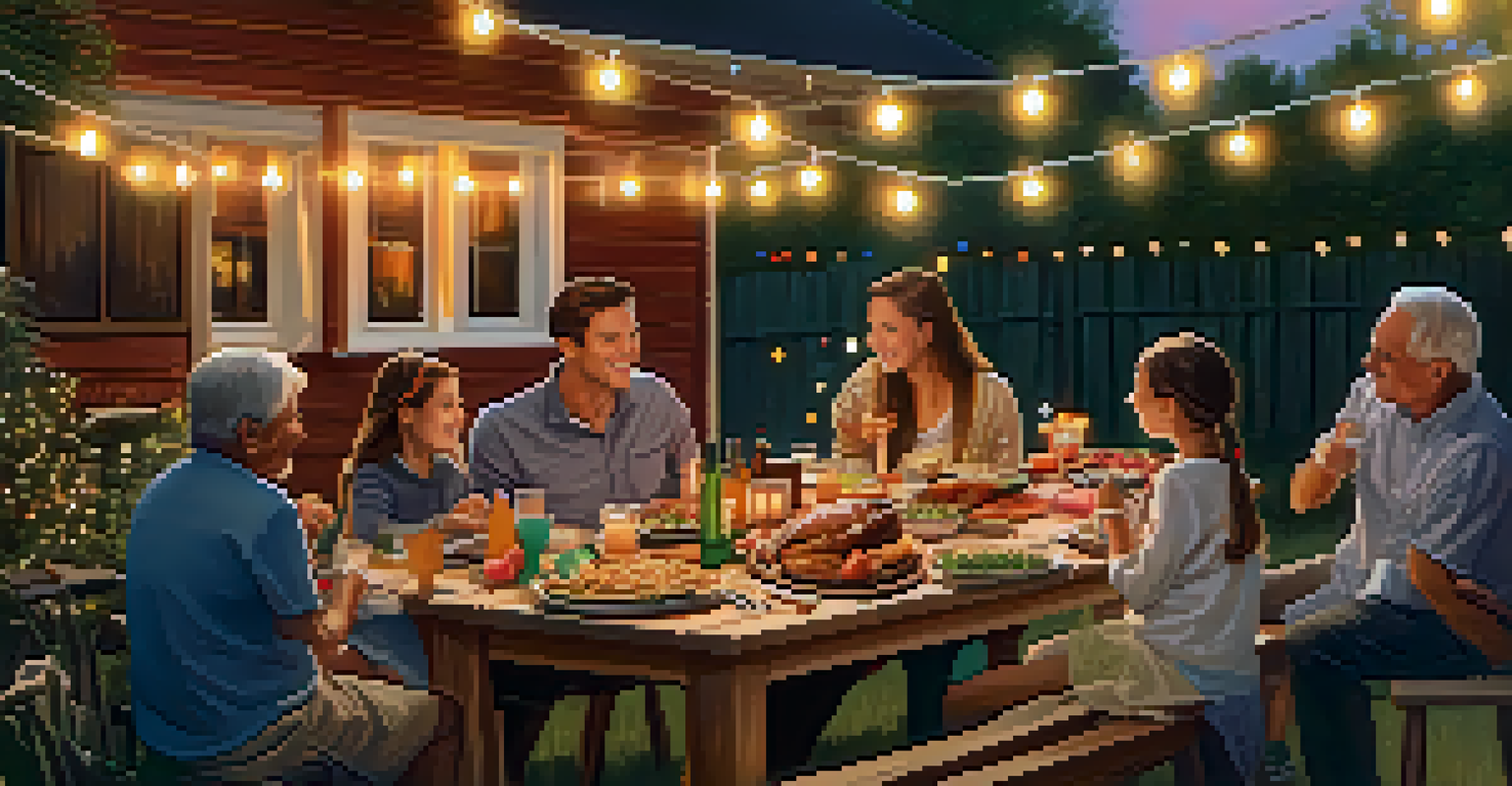The Benefits of Shared Childcare in Multi-Generational Homes

Understanding Multi-Generational Homes and Their Dynamics
Multi-generational homes are living arrangements where multiple generations, like grandparents, parents, and children, reside under one roof. This setup has become increasingly common as families look for ways to support one another in today's fast-paced world. With rising living costs and busy schedules, these homes offer a practical solution that benefits everyone involved.
The bond that links your true family is not one of blood, but of respect and joy in each other's life.
In these homes, the dynamics often shift, creating a unique environment where family members contribute to child-rearing. Grandparents can step in as caregivers, offering their wisdom and experience, while parents can focus on their careers or personal development. This collaborative approach not only eases the burden on parents but also strengthens family bonds.
Moreover, the presence of various generations creates a rich tapestry of experiences and traditions, allowing children to learn from their elders. This intergenerational interaction fosters respect, empathy, and understanding, essential traits in today's diverse society. Ultimately, multi-generational living can serve as a nurturing foundation for children.
Financial Benefits of Shared Childcare Arrangements
One of the most immediate advantages of shared childcare in multi-generational homes is the financial relief it offers. By having family members help with childcare, parents can save on expensive daycare costs and redirect those funds toward other essential areas, such as education or savings for the future. This financial flexibility can significantly improve a family's overall quality of life.

Additionally, shared responsibilities can lead to more efficient household management. For instance, when grandparents assist with childcare, parents may have more time to work or pursue additional income opportunities. This collaborative effort can create a more stable financial environment for everyone involved, reducing stress and anxiety.
Benefits of Multi-Generational Living
Multi-generational homes provide emotional support, shared responsibilities, and financial relief for families.
In the long run, multi-generational homes can offer a buffer against financial hardships. By pooling resources and sharing responsibilities, families can navigate economic challenges more effectively. This teamwork creates a safety net that can be invaluable during tough times.
Emotional Support Through Shared Childcare
Emotional well-being is crucial for both parents and children, and shared childcare can significantly enhance this aspect. With grandparents or other family members actively involved in caregiving, parents often find themselves less isolated in their parenting journey. Sharing experiences and challenges with loved ones can provide parents with the emotional support they need to thrive.
Family is not an important thing, it's everything.
Children also benefit emotionally from having multiple caregivers. A wider support network allows them to form strong attachments and feel secure in their environment. This sense of stability can contribute to better emotional regulation, resilience, and social skills, setting them up for future success.
Moreover, the presence of loving family members creates a nurturing atmosphere where children feel valued and understood. This emotional safety net fosters open communication, encouraging children to express their feelings and concerns freely. Ultimately, shared childcare can lead to healthier emotional development for everyone involved.
Enhanced Developmental Opportunities for Children
Shared childcare in multi-generational homes opens up a wealth of developmental opportunities for children. When grandparents or older relatives engage with young ones, they often introduce them to new skills, hobbies, and interests. Whether it’s gardening, cooking, or storytelling, these experiences enrich a child's learning and stimulate curiosity.
Furthermore, the diverse perspectives that come from various generations can broaden a child's understanding of the world. Engaging in conversations with older family members helps children develop critical thinking skills and learn about history and traditions in a relatable way. This intermingling of knowledge promotes lifelong learning and adaptability.
Cultural Transmission in Families
Living together allows grandparents to pass down traditions and cultural practices, enriching children's sense of identity.
Lastly, this nurturing environment allows children to learn essential life skills, such as empathy and communication, from their elders. Observing and interacting with different generations teaches children how to navigate relationships and understand diverse viewpoints, preparing them for future social interactions.
Building Stronger Family Bonds Through Shared Responsibilities
Shared childcare responsibilities can strengthen the bonds between family members. When everyone contributes to raising children, it fosters a sense of teamwork and collaboration. This shared mission can bring families closer, creating lasting memories and traditions that enrich their relationships.
Moreover, working together in caregiving roles allows family members to appreciate each other's strengths and skills. Parents may gain a new perspective on their parents' capabilities, leading to mutual respect and admiration. This newfound understanding can bridge generational gaps and foster a more harmonious family environment.
Ultimately, the shared experience of raising children in a multi-generational home creates a unique family culture. It cultivates a sense of belonging and connection, where every member feels valued and important. This strong family foundation can have a positive impact on children's self-esteem and overall well-being.
Cultural Transmission and Preservation in Families
One of the most beautiful aspects of multi-generational living is the opportunity for cultural transmission. Grandparents often serve as the gatekeepers of family traditions, stories, and cultural practices, ensuring that these valuable lessons are passed down to younger generations. This sharing of culture not only enriches children's lives but also fosters a sense of identity.
Participating in family traditions, whether it's cooking traditional meals or celebrating holidays in specific ways, helps children understand their heritage. This connection to their roots can instill a sense of pride and belonging, which is vital in today’s globalized world. It also encourages respect for diverse cultures and perspectives.
Navigating Challenges Effectively
Open communication and teamwork are essential for addressing generational differences and fostering a harmonious family environment.
Furthermore, as children learn about their family's history, they develop a greater appreciation for resilience and perseverance. Hearing stories of past struggles and triumphs can inspire them to face challenges with courage and determination. This cultural legacy becomes a source of strength for future generations.
Challenges and Solutions in Multi-Generational Childcare
While shared childcare in multi-generational homes offers numerous benefits, it also presents certain challenges. Differences in parenting styles and generational gaps can create tension, leading to misunderstandings between family members. It’s essential to address these disparities openly to foster a collaborative environment.
Effective communication is key to overcoming these challenges. Family meetings can provide a platform for discussing expectations, boundaries, and concerns. By establishing clear guidelines and respecting each other's perspectives, families can create a more harmonious living situation.

Additionally, setting aside quality time for family interactions can help strengthen relationships, allowing everyone to bond over shared experiences. Emphasizing teamwork in childcare can transform potential conflicts into opportunities for growth and understanding, making the family unit more resilient.
The Future of Shared Childcare in Multi-Generational Homes
As society continues to evolve, the concept of multi-generational living and shared childcare will likely become more prominent. With changing economic landscapes and shifting family dynamics, more families may find themselves seeking the support and companionship that multi-generational homes provide. This trend reflects a broader understanding of the importance of family connections.
Moreover, as awareness of the benefits of shared childcare grows, communities may begin to support these arrangements more actively. Local programs and resources can emerge to assist families in navigating the complexities of multi-generational living, ensuring that everyone can reap the benefits.
In conclusion, shared childcare in multi-generational homes not only enhances individual family dynamics but also contributes to a more connected society. As families embrace this model, we can expect to see stronger relationships, enriched lives, and a deeper appreciation for the value of family support.